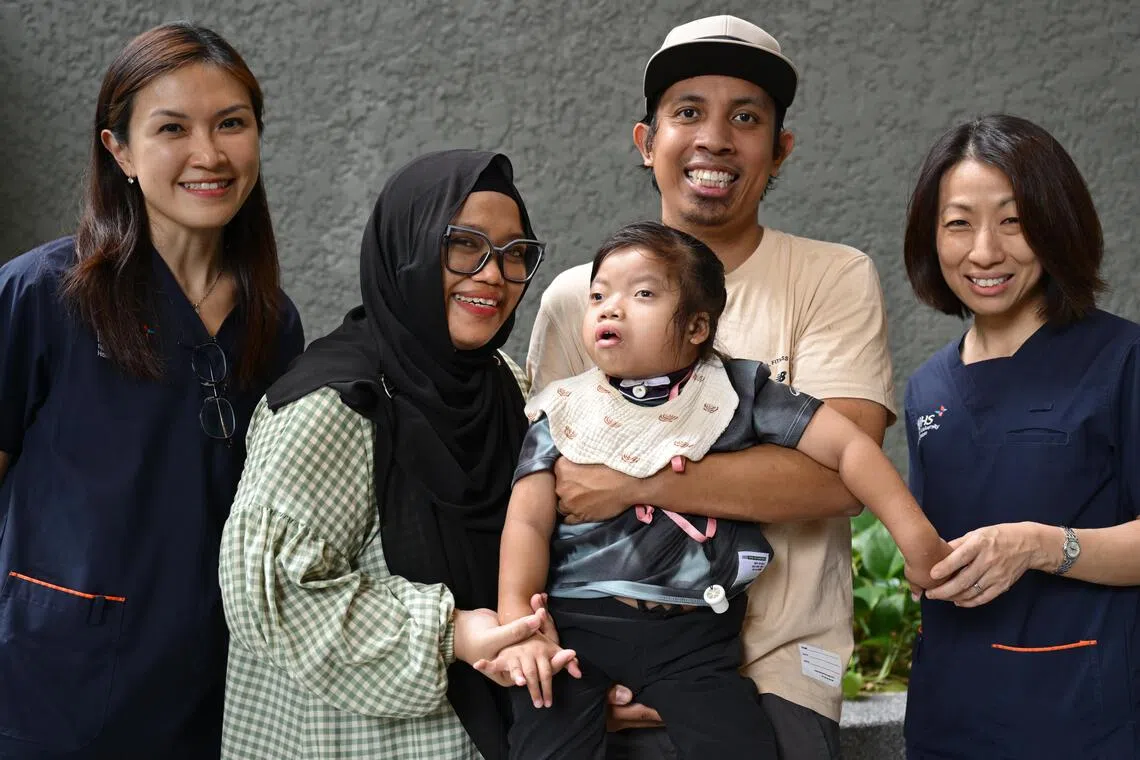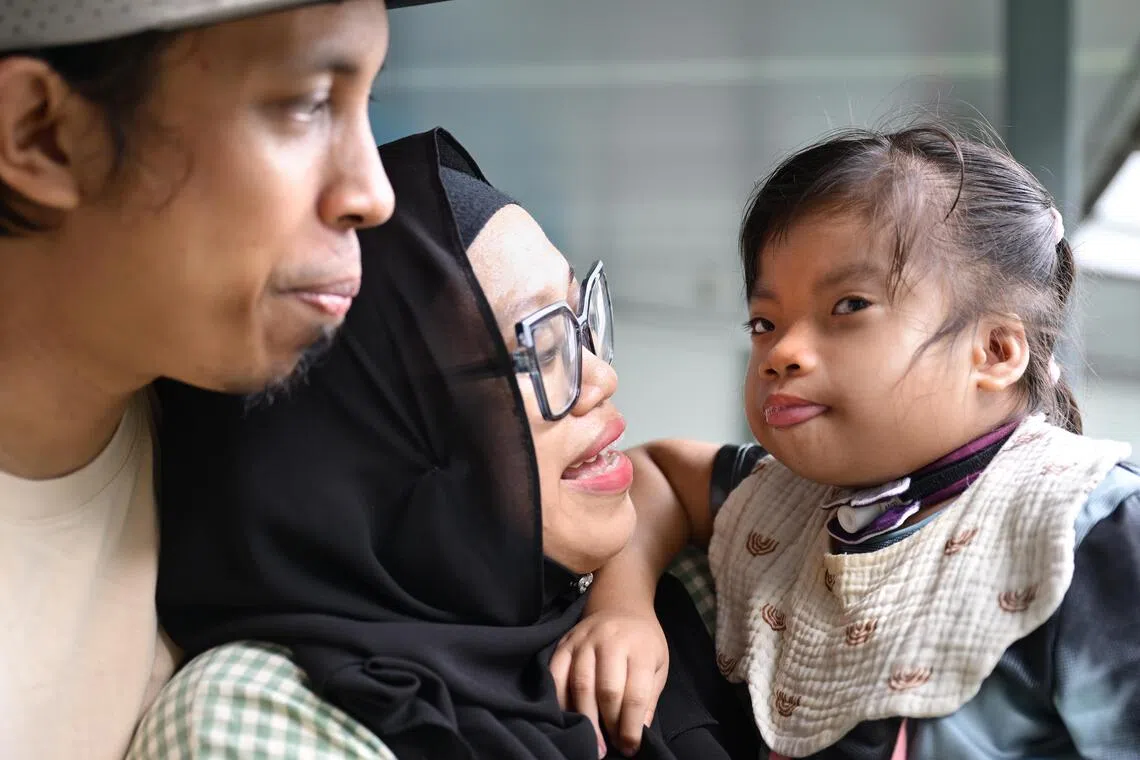SINGAPORE – When Rania Safiyya Ridzwan was born in 2020, there was eerie silence in the delivery room – she did not cry.
“She barely made a sound, and the doctors took a while to pink her up,” her mother, Madam Sri Syazwani Mohd Yazid, told The Straits Times, referring to the colour a newborn’s skin turns to when blood starts circulating properly.
The 34-year-old teacher said that although a stream of doctors had rushed into the delivery room, she had not been worried as the pregnancy had been uneventful and all the prenatal scans were normal.
“I was still high on the adrenaline of having given birth, so I did not think anything was wrong,” she added.
Madam Syazwani was later told that Raina, her third child, was very sick. “They rushed me in a wheelchair to the Nicu (neonatal intensive care unit), where my daughter was intubated and put on 100 per cent oxygen and (nitric oxide).”
Nicu is a specialised unit that provides critical care for premature infants and other newborn babies with serious health conditions.
“She had a floppy airway and would turn blue whenever the doctors removed the tube. The doctors had to perform surgery twice to remove and reshape excess tissue to improve Rania’s breathing. She eventually needed a tracheostomy (hole in the windpipe) to breathe,” Madam Syazwani said.
About five weeks after Rania’s birth, the family was referred to Adjunct Associate Professor Chin Hui-Lin, a geneticist with the Department of Paediatrics at Khoo Teck Puat – National University Children’s Medical Institute (KTP-NUCMI) at National University Hospital.
She ordered several genetic tests and one came back positive – for a rare genetic disorder called Kaufman oculocerebrofacial syndrome (KOS).
“It is a congenital disorder which arises because the affected person carries a mutation in both copies of the gene. That is, both parents are genetic carriers for such a rare condition and as carriers, they have no symptoms,” Prof Chin said.
Fewer than 100 KOS cases have been recorded worldwide, with only 36 diagnosed cases documented in scientific literature.
The condition is characterised by severe intellectual disability, distinctive craniofacial features and various congenital anomalies. The extent of physical malformation varies from person to person.
“Affected children are predisposed to having things like abnormally shaped eyes, visual impairment, hearing loss, floppy airways, which affect breathing and feeding, structural heart malformation, developmental delay, among other physical differences,” Prof Chin said.
She added that standard prenatal tests would not be able to pick up conditions such as KOS.
“Normal routine prenatal testing is done for conditions like Down syndrome, which checks for extra chromosomes. It does not read for the individual letter changes in the genes, which this condition (KOS) is,” she said.
Rania’s most severe malformation is her faulty airways, for which she initially needed breathing support.
“That malformation is not visible in the antenatal scan. Some of the other things, like her eyes being slightly smaller, would also not be obvious in the scans. The majority of her feeds are done through her gastronomy tube so she had that reflux that needed surgery to tighten the junction between the oesophagus and the stomach and the feeding pipe and the stomach, so the milk doesn’t go upward,” Prof Chin said.
Now that she is five years old, Rania does not need as much support for breathing, but the tracheostomy remains “because whenever she is sick, she produces more phlegm, so it helps her mother to suction out the excess phlegm”, Prof Chin said.
The respiratory doctors, as well as the ear, nose and throat specialists, hope to safely patch up Rania’s tracheostomy eventually.
But the girl also has bilateral renal hypoplasia, a condition in which both kidneys are very small, and this may result in kidney failure.
“Currently, she still has 70 to 80 per cent of normal kidney function, but if it deteriorates significantly down the road, she may need a transplant,” said Associate Professor Ng Kar Hui, a senior consultant at the Division of Paediatric Nephrology, Dialysis and Renal Transplantation in KTP-NUCMI’s Department of Paediatrics.
Raina’s father, Mr Ridzwan Kamis, 39, said he was shocked when he was first told of Rania’s condition. The couple’s first two children – both boys – did not have any health or medical issues, and there was no indication that Rania “would be a little bit abnormal”.

Rania Safiyya Ridzwan, five, is being looked after by a multidisciplinary team, which includes Adjunct Associate Professor Chin Hui-Lin (left) and Associate Professor Ng Kar Hui (right). With them are Rania’s parents, Madam Sri Syazwani and Mr Ridzwan Kamis.
ST PHOTO: NG SOR LUAN
While Madam Syazwani thought Mr Ridzwan, a deliveryman for a pharmaceutical company, would “freak out” on learning that their daughter needs specialised care, Mr Ridzwan proved her wrong.
He said: “I had to be strong for my family, my wife, who was weak from giving birth to our baby, and also because of my faith, I was able to accept what was given to me.”
Tearing at the memory, Madam Syazwani said: “When he gave me a hug and said this was our journey together, I was so relieved because I knew my husband did not blame me nor was he angry, and that we have each other. I cried. We cried.”
In 2022, Madam Syazwani became pregnant again and 22 weeks into her pregnancy, the foetus, a boy, was tested for KOS.
“I had to take medical leave that day for the test. I was alone then, but I felt I had to be strong for my mother and my husband, so I kept my emotions in check,” Madam Syazwani said.
The test result was positive and affected the heart. Doctors told the couple that the baby, whom they named Muhd Ruwaiq Syaihan, might not survive the pregnancy and even die soon after birth.
Abortion was not an option for the couple, and as soon as Ruwaiq was born in December 2022, he spent his next nine months in hospital, where he underwent many surgical procedures, including two open-heart operations.
“Yet he was cheeky and very manja (Malay for affectionate and clingy) towards me,” said Madam Syazwani. “I would carry him when I visited him every day after work. The Nicu nurse said his heart rate returned to normal whenever I was there.”
Ruwaiq was discharged from hospital in September 2023 after his parents were trained to take care of him.
But his condition went south at home and he was rushed back to hospital, where efforts to restart his heart failed. He died – on his mother’s birthday.
“I sought comfort that he got to go home and spend time with his siblings… I was still producing milk. I still have a few bottles of breast milk in the freezer, but I do not have the heart to throw them away,” Madam Syazwani said, tears streaming.
Meanwhile, Raina, despite her condition, can be rather boisterous when she is with her two elder brothers.
“My second son would often sneak into her bed to sleep beside her. Both boys love her a lot,” said their mother.
Rania’s future weighs heavy on her parents’ minds.
Said Madam Syazwani: “We do not really know if Rania will be able to talk or walk in the future, but we know she will grow at her own pace and as a family, we will be able to figure it out and support each other.”

